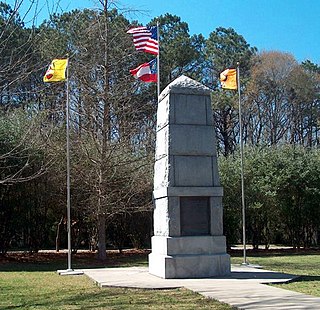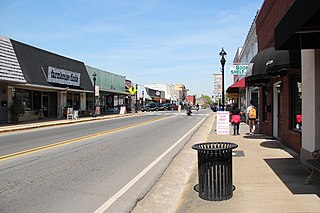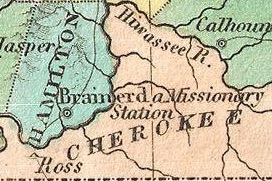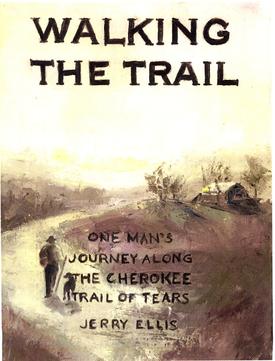
The Pony Express was an American express mail service that used relays of horse-mounted riders. It operated from April 3, 1860, to October 26, 1861, between Missouri and California. It was operated by the Central Overland California and Pikes Peak Express Company.

The Trail of Tears was an ethnic cleansing and forced displacement of approximately 60,000 people of the "Five Civilized Tribes" between 1830 and 1850 by the United States government. As part of the Indian removal, members of the Cherokee, Muscogee (Creek), Seminole, Chickasaw, and Choctaw nations were forcibly removed from their ancestral homelands in the Southeastern United States to newly designated Indian Territory west of the Mississippi River after the passage of the Indian Removal Act in 1830. The Cherokee removal in 1838 was brought on by the discovery of gold near Dahlonega, Georgia, in 1828, resulting in the Georgia Gold Rush.

DeKalb County is a county located in the northeastern part of the U.S. state of Alabama. As of the 2020 census, the population was 71,608. Its county seat is Fort Payne, and it is named after Major General Baron Johan DeKalb. DeKalb County is part of the Huntsville-Decatur-Albertville, AL Combined Statistical Area.

Crossville is a town in DeKalb County, Alabama, United States. At the 2010 census the population was 1,862, up from 1,431 in 2000. Crossville is located atop Sand Mountain, a southern extension of the Cumberland Plateau.

Fort Payne is a city in and county seat of DeKalb County, in northeastern Alabama, United States. At the 2020 census, the population was 14,877.

Golconda is a city in and the county seat of Pope County, Illinois, United States, located along the Ohio River. The population was 630 at the 2020 census. Most of the city is part of the Golconda Historic District.
There are many historic trails and roads in the United States which were important to the settlement and development of the United States including those used by American Indians.

The Laramie Plains is an arid highland at an elevation of approx. 8,000 feet (2,400 m) in south central Wyoming in the United States. The plains extend along the upper basin of the Laramie River on the east side of the Medicine Bow Range. The city of Laramie is the largest community in the valley. The plains are separated from the Great Plains to the east by the Laramie Mountains, a spur of the Front Range that extends northward from Larimer County, Colorado west of Cheyenne. The high altitude of the region makes for a cold climate and a relatively short growing season. Unsuitable to most cultivation, the plains have historically been used for livestock raising, primarily of sheep and cattle.
Willstown was an important Cherokee town of the late 18th and early 19th century, located in the southwesternmost part of the Cherokee Nation, in what is now DeKalb County, Alabama. It was near Lookout or Little Wills Creek.

Junaluska, was a leader of Cherokee who resided in towns in western North Carolina in the early 19th century. He fought alongside Andrew Jackson at the Battle of Horseshoe Bend during the War of 1812/Creek War. In the course of the battle he saved Jackson's life, an act he reportedly regretted later in life.
Fort Cass was a fort located on the Hiwassee River in present-day Charleston, Tennessee, that served as the military operational headquarters for the entire Cherokee removal, an forced migration of the Cherokee known as the Trail of Tears from their ancestral homelands in the Southeast to Indian Territory in present-day Oklahoma. Fort Cass housed a garrison of United States troops who watched over the largest concentration of internment camps where Cherokee were kept during the summer of 1838 before starting the main trek west to Indian Territory, and served as one of three emigration deports where the Cherokee began their journey west, the others of which were located at Ross's Landing in Chattanooga and Gunter's Landing near Guntersville, Alabama.

State Route 35 (SR 35) is a 68.291-mile-long (109.904 km) state highway in the northeastern part of the U.S. state of Alabama. The southern terminus of the highway is at its intersection with SR 9 in rural Cherokee County northeast of Cedar Bluff and near the Georgia state line. The northern terminus of the highway is at Woodville in Jackson County where it has a second intersection with U.S. Route 72 (US 72).

Pushing the Bear is a historical novel by Diane Glancy which explores the lives of the Cherokee in 1838/39 during their forced removal from their land along the Trail of Tears in the United States. The book was published in 1996 by Harcourt.
The Overland Trail was a stagecoach and wagon trail in the American West during the 19th century. While portions of the route had been used by explorers and trappers since the 1820s, the Overland Trail was most heavily used in the 1860s as a route alternative to the Oregon, California, and Mormon trails through central Wyoming. The Overland Trail was famously used by the Overland Stage Company owned by Ben Holladay to run mail and passengers to Salt Lake City, Utah, via stagecoaches in the early 1860s. Starting from Atchison, Kansas, the trail descended into Colorado before looping back up to southern Wyoming and rejoining the Oregon Trail at Fort Bridger. The stage line operated until 1869 when the completion of the First transcontinental railroad eliminated the need for mail service via stagecoach.

Cherokee removal, part of the Trail of Tears, refers to the forced relocation between 1836 and 1839 of an estimated 16,000 members of the Cherokee Nation and 1,000–2,000 of their slaves; from their lands in Georgia, South Carolina, North Carolina, Tennessee, and Alabama to the Indian Territory in the then Western United States, and the resultant deaths along the way and at the end of the movement of an estimated 4,000 Cherokee and unknown number of slaves, although no records of these deaths have ever materialized. Many scholars believe these Indians absconded from the removal rather than died.
Manitou Cave is a cave in Alabama, near the town of Fort Payne, in the side of Lookout Mountain. In the early 1800's, the Fort Payne area was a Cherokee settlement named Willstown. This was the home of Sequoyah during his time of creating the Cherokee syllabary. Later, Sequoyah's son wrote on the walls of Manitou Cave using this syllabary, documenting ceremonial events and other culturally significant information and history. In the 1830's, Cherokee people were forcibly relocated from this area along the Trail of Tears, leaving the cave empty for some time. During the Civil War, the cave was a source of saltpeter for the Confederate Army. The mineral was mined by laborers to provide the essential ingredient for black powder. The cave was also designated fallout shelter during the Cold War.

Cherokee Plantation is a historic house in Fort Payne, Alabama. The house was built in 1790 as a two-story log cabin by Andrew Ross, a judge on the Cherokee Supreme Court and brother of Principal Chief John Ross. In 1834 a second log cabin was built connected to the rear of the original cabin, and a third was built to the northeast, separated by a breezeway. Ross, being one-eighth Cherokee, was forced to leave his home in 1838 under the provisions of the Treaty of New Echota, of which Ross was a signatory; a portion of the Cherokee Trail of Tears passes in front of the house.

Walking the Trail: One Man's Journey along the Cherokee Trail of Tears is the 1991 book by Jerry Ellis telling the story of his 900-mile walk along the Cherokee Trail of Tears, the same walk his ancestors were forced to take in 1838. Walking the Trail has been used in classrooms and as a teaching resource by award-winning educators, including James Percoco who is in the National Teachers Hall of Fame.
Fort Likens was a temporary stockade fort built in 1838 in present-day Cherokee County, Alabama. The fort was used to house soldiers who participated in the Cherokee removal.













